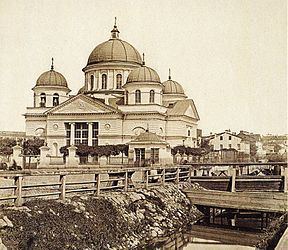Status 90 % closed Date completed 1721 | Principal engineer G. Skornyakov-Pisarev Construction began 1718 | |
 | ||
Maximum height above sea level 78.9 ft (24.0 m)(Difference between a mouth and a source in meter) Date closed 1891, 1926 and 1965-1969 Similar Obvodny Canal, Ligovo railway station, Panteleymonovsky Bridge, Griboyedov Canal, Moscow Triumphal Gate | ||
Ligovsky Canal (Russian: Ли́говский кана́л) is one of the most extended channels of Saint Petersburg (Russia). Constructed in 1721, it is 23 kilometres (14 mi) long. Its purpose was to supply water for the fountains of the Summer Garden. The channel delivered water from the Liga River (now called the Dudergofka) to ponds in Bassejnaya Street (modern Nekrasov Street).
Contents
Map of Ligovskiy kan., St Petersburg, Russia
History
The idea of construction of the channel belongs to the Russian emperor and reformer Peter I. He decided to decorate the Summer Garden with fountains supplied by water delivered by gravity feed. A small river, Liga (now called the Dudergofka), near (Dudergofskoye Lake), became a water source. The project designer was G. Skornyakov-Pisarev, who also supervised the channel construction.
Except the basic function of actuating of fountains, the canal was used as a water main and as a defensive boundary, protecting the capital on the southeast. The project was completed in three years, 1718–21. It is known that the channel crossed at least two bridges, one at Moskovsky Prospekt and one at Znamenskya Square (in a photo). Later at building Obvodny Canal in the beginning 20th century has been constructed Yamskoi Vodoprovodniy Aqueduct, author of the project of the wooden bridge became Russian engineer Ivan Gerard. Later the bridge under Leninsky Prospekt has been constructed; Data on its dismantling are not present, it is probable it is filled up together with the channel and has remained underground.
Flooding of 21 September [O.S. 10 September] 1777 destroyed the fountains of the Summer Garden and the reason for the channel disappeared. In addition, the water in the channel became muddy and undrinkable. The channel gradually became unfit for use and was filled up in stages:
In its place, Ligovsky Avenue was laid.
Facts
Now near a railway line to luga channel waters go on an underground channel and leave on a surface near to Krasnenkaya River. There the canal is divided into two sleeves: on bigger canal waters are taken away in the Krasnenkaya River, smaller an underground site leaves in ponds of Aviatorov Garden. The length of the remaining part is 11 kilometres (7 mi).
On the bank of the channel in 1834–38 was constructed the Moscow Triumphal Gate. It was built mainly in cast iron.
The filled-up Ligovsky Canal became a hindrance to construction of a metro station Ploshchad Vosstaniya - at sinking an inclined tunnel of an exit on a surface wet stratum have strongly complicated works. They should be overcome, applying a caisson and to a breed frost a hydrochloric solution in 1950.
